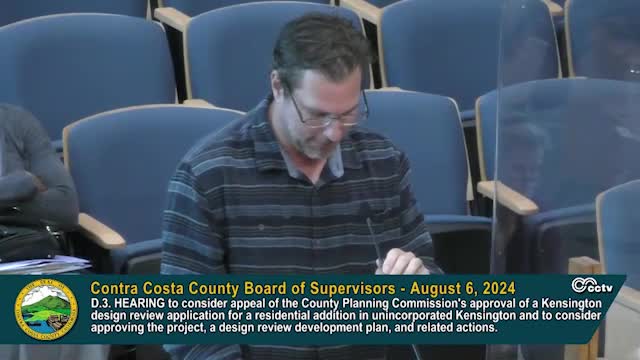Neighbors Clash Over Home Addition Amid View Dispute
August 08, 2024 | Contra Costa County, California
This article was created by AI summarizing key points discussed. AI makes mistakes, so for full details and context, please refer to the video of the full meeting. Please report any errors so we can fix them. Report an error »

In a recent government meeting, a contentious discussion unfolded regarding a proposed home addition that has sparked significant debate between neighbors in Kensington. The meeting highlighted the clash between property rights and the preservation of views, as both parties presented their arguments concerning the impact of the development.
The applicant, representing a family of four, argued that their modest addition is essential for hosting gatherings and improving their living space. They expressed surprise at the intensity of opposition from their neighbor, who claimed that the addition would obstruct her view, despite having blinds closed at all times over her south-facing window. The applicant emphasized that their project had received support from various local committees and urged the board to approve the plans.
Conversely, the neighbor, identified as Miss McLean, raised concerns about the legal implications of the project, arguing that it would violate existing codes and diminish her property value and quality of life. She highlighted the emotional toll of the situation, stating that the process had been frustrating and misrepresented. McLean called for a reasonable compromise, suggesting that both parties should be willing to make concessions to maintain neighborly relations.
The board members acknowledged the complexity of the situation, noting the subjective nature of property impacts, particularly concerning views and light access. Supervisor Joya, who visited both properties, recognized that while the proposed addition would not entirely block the primary view of the bay, it would still affect the secondary view of Emeryville. He proposed a potential solution: lowering the height of the addition by 22 to 24 inches to mitigate its impact on the neighbor's sight lines while retaining the overall design.
The meeting concluded with a recommendation for the applicant to revise their plans in accordance with the board's suggestions, aiming to balance the rights of property owners with the need to minimize impacts on surrounding neighbors. The decision reflects ongoing challenges in urban development, where individual desires often conflict with community standards and neighborly considerations.
The applicant, representing a family of four, argued that their modest addition is essential for hosting gatherings and improving their living space. They expressed surprise at the intensity of opposition from their neighbor, who claimed that the addition would obstruct her view, despite having blinds closed at all times over her south-facing window. The applicant emphasized that their project had received support from various local committees and urged the board to approve the plans.
Conversely, the neighbor, identified as Miss McLean, raised concerns about the legal implications of the project, arguing that it would violate existing codes and diminish her property value and quality of life. She highlighted the emotional toll of the situation, stating that the process had been frustrating and misrepresented. McLean called for a reasonable compromise, suggesting that both parties should be willing to make concessions to maintain neighborly relations.
The board members acknowledged the complexity of the situation, noting the subjective nature of property impacts, particularly concerning views and light access. Supervisor Joya, who visited both properties, recognized that while the proposed addition would not entirely block the primary view of the bay, it would still affect the secondary view of Emeryville. He proposed a potential solution: lowering the height of the addition by 22 to 24 inches to mitigate its impact on the neighbor's sight lines while retaining the overall design.
The meeting concluded with a recommendation for the applicant to revise their plans in accordance with the board's suggestions, aiming to balance the rights of property owners with the need to minimize impacts on surrounding neighbors. The decision reflects ongoing challenges in urban development, where individual desires often conflict with community standards and neighborly considerations.
View full meeting
This article is based on a recent meeting—watch the full video and explore the complete transcript for deeper insights into the discussion.
View full meeting
